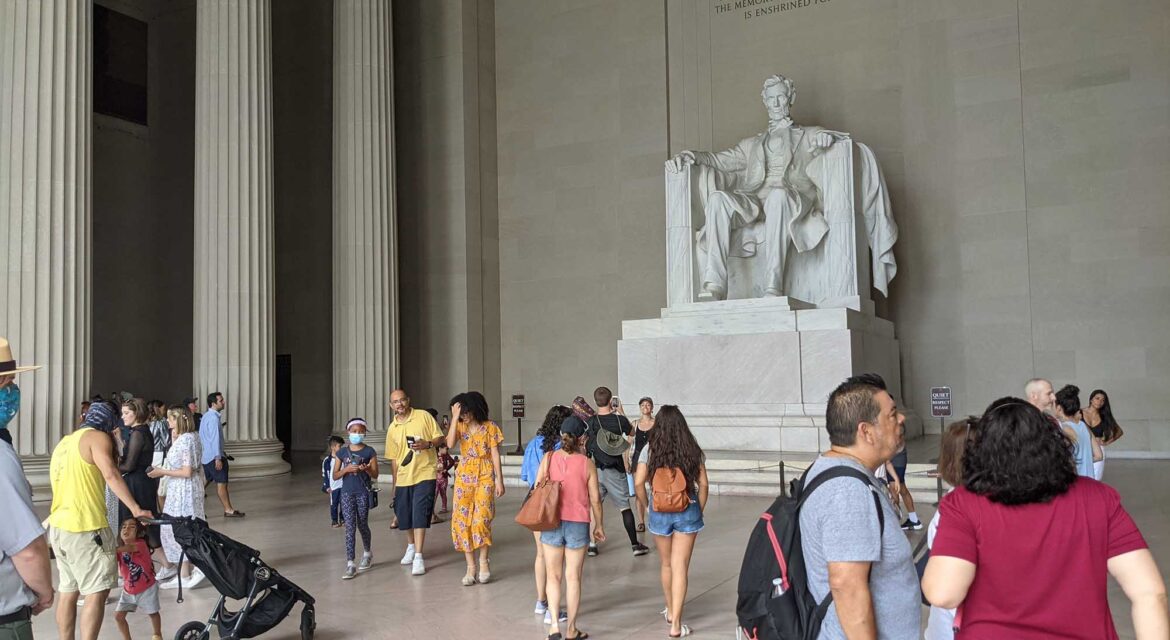 Built to honor United States President Abraham Lincoln, the Lincoln Memorial has become one of the most notable monuments in America and an essential element of Washington D.C. Built at a monumentous scale and scope to be a literal temple to democracy, the landmark has come to serve as a commemoration of an individual as well as a celebration of a national legacy.
Built to honor United States President Abraham Lincoln, the Lincoln Memorial has become one of the most notable monuments in America and an essential element of Washington D.C. Built at a monumentous scale and scope to be a literal temple to democracy, the landmark has come to serve as a commemoration of an individual as well as a celebration of a national legacy.

Transforming the Potomac Flats
 A desire to create a monument dedicated to the 16th President of the United States took shape soon after Abraham Lincoln’s assassination in 1865. However, nothing came of these efforts until 1910 when a plan for a memorial that would honor President Lincoln was finalized. Construction began in 1914 in the swampy area west of the National Mall and Washington Monument in an area that was known as the Potomac Flats in 1914. The building was dedicated in 1922 before more than 50,000 people, including Lincoln’s only surviving son, Robert Todd Lincoln.
A desire to create a monument dedicated to the 16th President of the United States took shape soon after Abraham Lincoln’s assassination in 1865. However, nothing came of these efforts until 1910 when a plan for a memorial that would honor President Lincoln was finalized. Construction began in 1914 in the swampy area west of the National Mall and Washington Monument in an area that was known as the Potomac Flats in 1914. The building was dedicated in 1922 before more than 50,000 people, including Lincoln’s only surviving son, Robert Todd Lincoln.
At 190 feet long, 120 feet wide and almost 100 feet tall, the Lincoln Memorial is imposing on multiple levels. Based on a plan similar to that of the Parthenon in Athens, it is surrounded by 36 fluted Doric columns, one for each of the 36 states in the Union at the time of Lincoln’s death. Above the colonnade are the names of the 36 states and the dates in which they entered the Union. The names of the 48 states present at the time of the dedication are inscribed at the top of the memorial, with Alaska and Hawaii mentioned on a marker on the plaza.
The interior of the Lincoln Memorial is divided into three chambers, with two rows of ionic columns separating each. The two side chambers feature inscriptions from his speeches and murals that show governing principles important in Lincoln’s life, while the main chamber is dominated by the statue of Abraham Lincoln. The finished statue is 19 feet tall, carved from 28 blocks of white Georgia marble. It depicts him sitting in contemplation.
All of these elements have come together to define a monument that has impacted the culture and economy of Washington D.C. in a profound manner.

Impacting the Culture and Economy of Washington D.C.
 The Lincoln Steps and Plaza became an important symbol of the American Civil Rights movement in the 1960s. In 1963, civil rights leader Martin Luther King, Jr., delivered his famous “I Have a Dream” speech from the steps of the Lincoln Memorial in front of more than 200,000 people. Contemporary events and protests continue to take place in front of the monument.
The Lincoln Steps and Plaza became an important symbol of the American Civil Rights movement in the 1960s. In 1963, civil rights leader Martin Luther King, Jr., delivered his famous “I Have a Dream” speech from the steps of the Lincoln Memorial in front of more than 200,000 people. Contemporary events and protests continue to take place in front of the monument.
The Lincoln Memorial Reflecting Pool has become one of the most recognizable and filmed sites in Washington, DC. The Reflecting Pool area has been the site of many historic events and continues to host events that range from concerts to festivals. It welcomes many of the 24 million visitors a year who visit the National Mall.
The cultural significance of the monument is connected to a direct economic impact, which can be seen with the products and merchandise for sale that incorporates the Lincoln Memorial in one way or another. Countless stores and businesses utilize icons and symbols associated with the Lincoln Memorial to promote their services and convey a sense of identity, showcasing the impact it has made on audiences in the area and beyond.
Listed on the National Register of Historic Places in 1966 and commonly mentioned as the most popular monument in the United States, the Lincoln Memorial has been able to connect with the hearts and minds of audiences across the eras. Built at a scale and scope that have helped it do so, the timeless nature of the symbols, concepts and ideals that it represents have allowed it to define an American legacy that everyone can interpret in their own manner.

Notoriety of the Past and Serenity of the Present
 Open to the public 24 hours a day, more than seven million people visit the Lincoln Memorial every year. Equally enabling visitors to connect with the notoriety of the past as well as the serenity of the present, it highlights how many different ways a monument can make positive changes for a space, city and nation.
Open to the public 24 hours a day, more than seven million people visit the Lincoln Memorial every year. Equally enabling visitors to connect with the notoriety of the past as well as the serenity of the present, it highlights how many different ways a monument can make positive changes for a space, city and nation.

